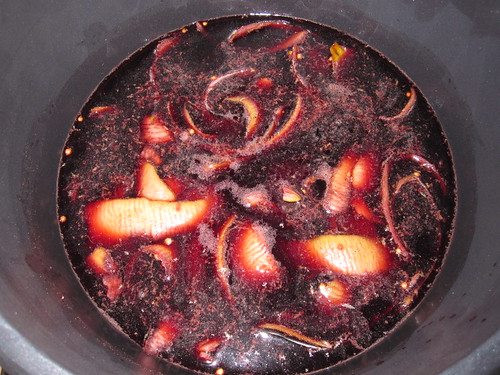One thing I decided some time ago was the dessert - Pears in Wine. This dish was very appealing to me, both visually and on a conceptual level, plus that it seemed kind of fitting to do for a Christmas meal, since in making it, the wine is effectively mulled.

After reading through a few recipes, I decided to follow the one in my Larousse Gastronomique of 2001. In fact, the dessert "Poirissimo" was very appealing, but it constitutes of pear compote, pear conserve, pears in wine, pear tart and pear granita. This would be very far away from being practical, and could perhaps be implemented as a meal on its own. But the Pears in Wine were doable and would have to be this year's Christmas dessert. As always with some involuntary changes - I couldn't get hold of the suggested Williams pears. To be honest, I just couldn't be bothered to wander around the shops just for that. Just finding a place to park outside each shop is plain impossible in December.
Ingredients
1 lemon
4 - 8 (depending on size) Comice pears without blemishes
1 litre red wine (Côtes du Rhône or Madiran)
100 g honey
150 g soft brown sugar
0.25 tsp white pepper
15 - 20 whole coriander seeds
0.25 tsp grated nutmeg
3 vanilla pods
whipping cream and icing sugar (optional, for serving)
Method
- Wash the lemon and the pears well and dry off the water.
- Grate the lemon zest finely and place it in a deep saucepan which is large enough for all the pears to stand. Cut the lemon in half.
- Cut the bottom of each pear, so that it can stand up, then peel them, but leave the stalks intact. Using the lemon halves, rub the peeled pears, squeezing the lemon as you go. This should prevent them from discolouring.

- Place the peels and the cut off bottoms into the pan, add the wine, honey, sugar, white pepper, coriander seeds and nutmeg. Cut the vanilla pods in two, then slit each half lengthwise and add to the saucepan.
- Bring to the boil and let simmer for about 10 minutes, stirring a couple of times to make sure the spices and sugar are mixed through.

- Now add the pears to the saucepan. Ideally they should be covered by the liquid up to the stalks. Now cook slowly for 20 - 35 minutes, depending on pear size. If the pears can't be fully covered, place them on their sides and if they still stick up, turn them a couple of times during the cooking.

- Remove from the heat and allow to cool down completely, transfer to a deep dish with a lid or cover with clingfilm and chill in the fridge along with the cooking liquid for at least 24 h. This dish is served cold with some of the cooking sauce and some sweetened whipped cream.
The book didn't mention cutting off the bottoms of the pears so they can stand up and so I didn't do this, but it's important, especially for presentation when serving. The recipe stated 8 Williams pears, but Comice pears tend to be quite a bit bigger, so I bought 4. I could possibly have fitted two more in the casserole but I wasn't sure and didn't want to risk it, I very much regret this, now that I've tasted this fabulous dessert.
It's quite fascinating to watch the pears get infused with the dark red of the wine and in fact, storing them in the cooking liquid continues this process and you can always see which parts of the pear haven't been in the liquid. The book implied that the cooking sauce would gel after the chilling and perhaps it might do that if Williams pears are used. It remained as thin as when it started in my case, which didn't really matter. However I can see two solutions to this - heat up some of the sauce with ground arrowroot and then brush the pears before serving or add some peel and pieces of quince, which is so full of pectin, it will give the same result. And with the added bonus of some of the delicate quince flavour.
I was also very careful with the white pepper, the coriander seeds and nutmeg, I should have been more generous and I've accounted for that in the ingredients' list above. Some experimentation here would be good too - perhaps use some cloves, star anise, cinnamon or orange zest.
As for serving, I had about 1.5 dl whipping cream left over and I added 1.5 tsp of icing sugar and whipped it. As it turns out it was a good combination.
Eating the pears provided a slight challenge - you definitely need a fork and knife. Care is also required or the pear could easily shoot across the table and stain something badly. Again, cutting the bottoms might prove helpful here. I quite liked that the red wine hadn't penetrated through too deep, so the pear looked rather pretty while eating it as well.

I also have plans for the remaining wine juices - heating them up with a little brandy should result in a quite nice mulled wine I think.
Needless to say, I was pretty pleased with myself after this.
No comments:
Post a Comment